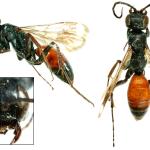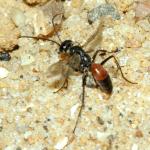Females of this species are readily confused with Priocnemis pusillus, P. cordivalvata and P. gracilis, although the males are readily distinguishable. Keys to species and general biology are given in Richards & Hamm (1939), Wolf (1972), Day (1988) and Falk (1991).
South Devon to east Kent, north to east Inverness-shire and Moray. Also the Channel Islands. A scarce species, although in northern England it can be abundant flying low over dry sandy soils (M E Archer pers. obs.).
Overseas, found in northern and middle Europe. A melanic form occurs in southern Europe.
Listed by Falk (1991) as a nationally scarce (Nb) species.
Usually in open situations on sandy soils but also on limestone grassland, along old hedges and earth exposures on road verges, and open areas in woodland on sandy soils.
Probably univoltine. Females fly mainly during July and August, but also during June and September and rarely during October. Males mainly fly during July but also during June and August.
Spiders, probably of the family Clubionidae, but also Gnaphosidae, Salticidae and Lycosidae.
After mating the female starts hunting for a spider. The captured spider is paralysed and then hidden. The female then digs a burrow, although she often takes advantage of natural cavities and abandoned burrows. The spider-prey is stored in a cell and an egg is laid, usually on its abdomen. The entrance tunnel, which is probably short, leads to several cells. The same female may prepare and provision several such nests. The young probably overwinter as mature larvae.
No information available.
2002



